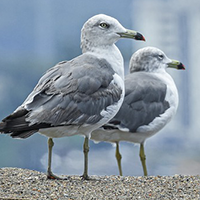 The double-crested cormorant is a large greenish-black bird found throughout the Great Lakes and is the only fish eating species which is commonly seen around bodies of fresh water. These birds are very sociable year round and nest in colonies usually building their nests on the ground near water.
The double-crested cormorant is a large greenish-black bird found throughout the Great Lakes and is the only fish eating species which is commonly seen around bodies of fresh water. These birds are very sociable year round and nest in colonies usually building their nests on the ground near water.
Cormorants lay three to four light blue eggs which hatch after about 25-28 days of incubation. The birds incubate their eggs by wrapping the webs of their feet around them. The cormorants diet consists primarily of fish and sometimes includes small invertebrates such as crayfish. These birds are becoming a huge nuisance along the Great Lakes basin. In northern Lake Michigan commericial fisherman are finding the bodies of cormorants entangled in their nets. Both the walleye and perch populations have been drastically reduced in Lake Erie by these voracious hunters. Numerous islands located within the Great Lakes system that were once lush with greenery lie devastated and barren because of the explosive population growth of these bird.
Cormorants Control
Falconry using eagles, falcons and hawks to chase and re-locate birds. Pyrotechnics to scare them off as well as exclusion netting to keep them from settling in ponds on neighboring properties. Nest removal plays a part in re-locating the birds.
Please note: Cormorants are a protected species; a special permit is required for all control methods.
















